The early history of motorcycle design shows a great deal of variation. This page, in accordance with the philosophy of The Museum of RetroTech, deals only with really unusual motorcycles.

PROPELLOR-DRIVEN MOTORCYCLES
These have now been moved to their own gallery: Propellor-driven Motorcycles.

PUSHER-ASSISTED BICYCLE
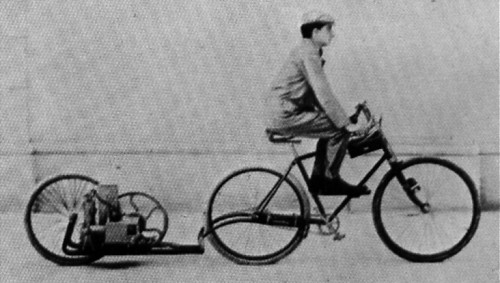 |
| Left: The pusher-assisted bicycle. Italy 1893.
The engine on the little trolley at the rear appears to be a single-cylinder unit with a big flywheel, pushing a conventional bicycle. The rider has his feet on what appear to be two platforms each side- possibly because the bicycle had no freewheel, so the pedals would have been whizzing round.
No control connections are visible between bicycle and engine, which is rather puzzling.
|

TANDEM MOTORCYCLES
There is nothing unusual about having a pillion rider, but a tandem motorcycle is rather different; no passengers are carried, the man at the back being expected to contribute his share of "light pedal assistance" when necessary. The motor or engine was placed between the two riders.
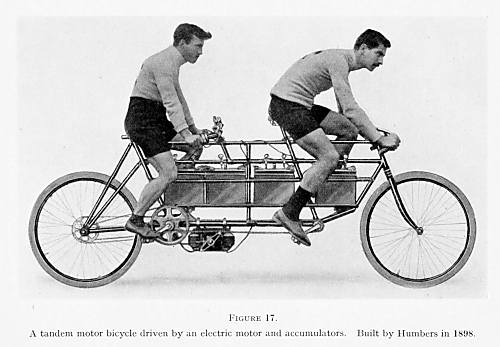 |
| Left: The Humber electric tandem: 1897
With four accumulators and an electric motor, plus pedal power from two riders, this machine should have been capable of a fair turn of speed. It was not a one-off. An example was shown at the Stanley Show in November 1897.
These machines were intended for pacing at cycle racing tracks, as indicated by the athletic costume of our intrepid riders. The small capacity of the accumulators made road use impractical.
|
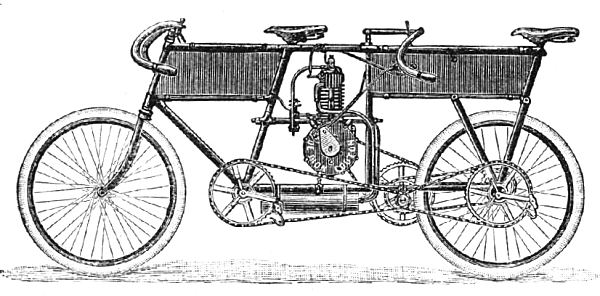 |
| Left: The Richard-Choubersky petrol tandem: 1899
Nothing is known about this machine except its name. The company also invented and made a form of roller-skate in 1898, and at least one motor-tricycle. Note the De Dion-Bouton engine, and the rear pedals coaxial with the rear wheel. The extra room required for the engine meant the rear rider actually sat behind the rear wheel.
From the French journal La Nature, reprinted by Scientific American Supplement, 9 Dec 1899, p20022
|
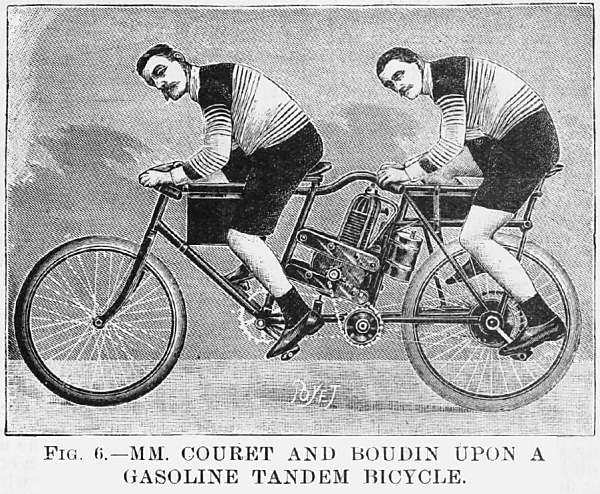 |
| Left: Unknown petrol tandem: 1899
Couret and Boudin were presumably riders rather than the inventors, but that remains uncertain. They are unknown to Google.
The author of the Scientific American Supplement article was unimpressed by the idea of a tandem motor cycle. Talking of their use for training racers, he says: "...such machines do not appear to be any more advantageous than the bicycle for this special application. They are heavier and their speed is no greater by reason of the greater friction that the motor has to overcome; and so we think that the bicycle for one rider possesses more advantages and will, ere long, be master of the road ." Clearly he did not foresee engines powerful enough to pull along a passive pillion rider.
This picture reminds me irresistibly of the works of Edward Gorey.
From the French journal La Nature, reprinted by Scientific American Supplement, 9 Dec 1899, p20022
|

THE THOR MOTORCYCLE/MOPED
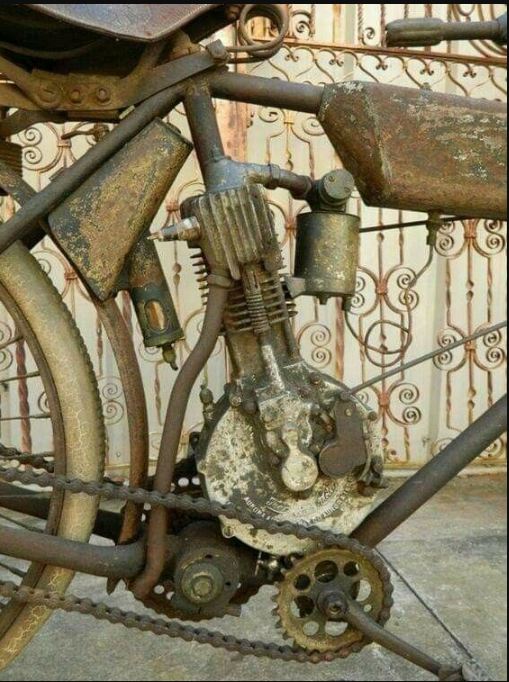 |
| Left: The Thor motorcycle/moped: 1901-1916
Here the engine makes up part of the frame, which I think qualifies as unusual. Note that pedals are fitted so it could be argued this is more of a moped. The carburettor feeds into the cylinder via a joint in the frame just above.
Thor motorcycles was founded in 1901 and ceased production in 1916, but the parent Aurora Automatic Machinery Company survived. This looks like an early and somewhat crude model.
The Thor has a Wikipedia page, but the engine-as-frame feature is not mentioned.
|

THE HOLDEN MOTORCYCLES
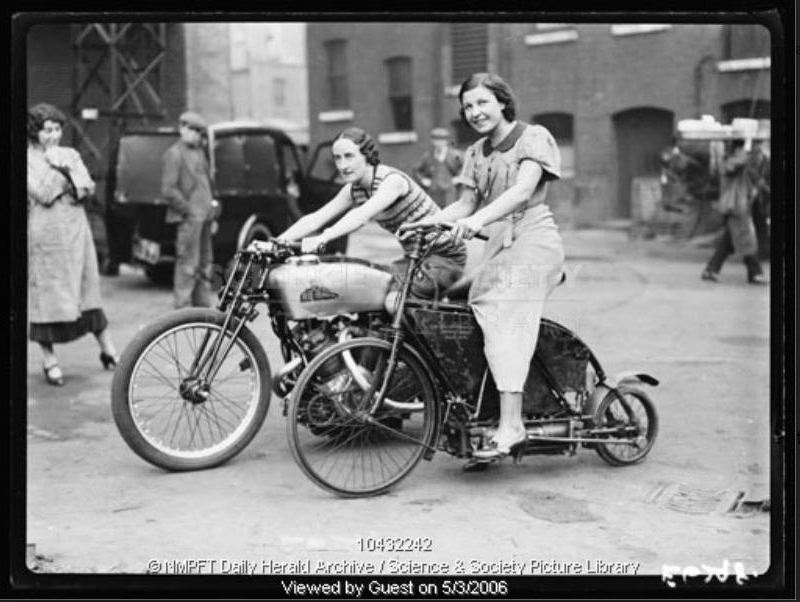 |
| Left: The Holden motorcycle: 1902
The odd machine at the front is a liquid-cooled 1902 Holden 3HP Motorcycle designed by Colonel Sir Henry Capel Holden; some sources say he was Brigadier-General Sir Henry Capel Holden. It had a four-cylinder engine with two sets of opposed cylinders, driving a crank on either side of the rather small rear wheel. (No doubt to achieve something like a correct 'gear ratio') It was the first four-cylinder motorcycle ever built. This picture appears to have been taken in the Twenties or thereabouts.
The first Holden machines were air-cooled, and prone to seizing. Later version used water-cooling; the machine was heavy and expensive, and had little market penetration.
The picture shows Marjorie Cottle on a New Imperial V-twin at the rear, probably promoting Brooklands racetrack, which was also designed by Sir Henry Capel Holden in 1906. Whitewebbs Museum in Enfield, near London, has a liquid-cooled four-cylinder Holden and it is thought this is the one in the picture.
Thanks to Steven McDonald for drawing this machine to my attention.
|
 |
| Left: The Holden motorcycle: 1902
The Holden motorcycle does not appear to have a Wikipedia page. There is much more information here.
|
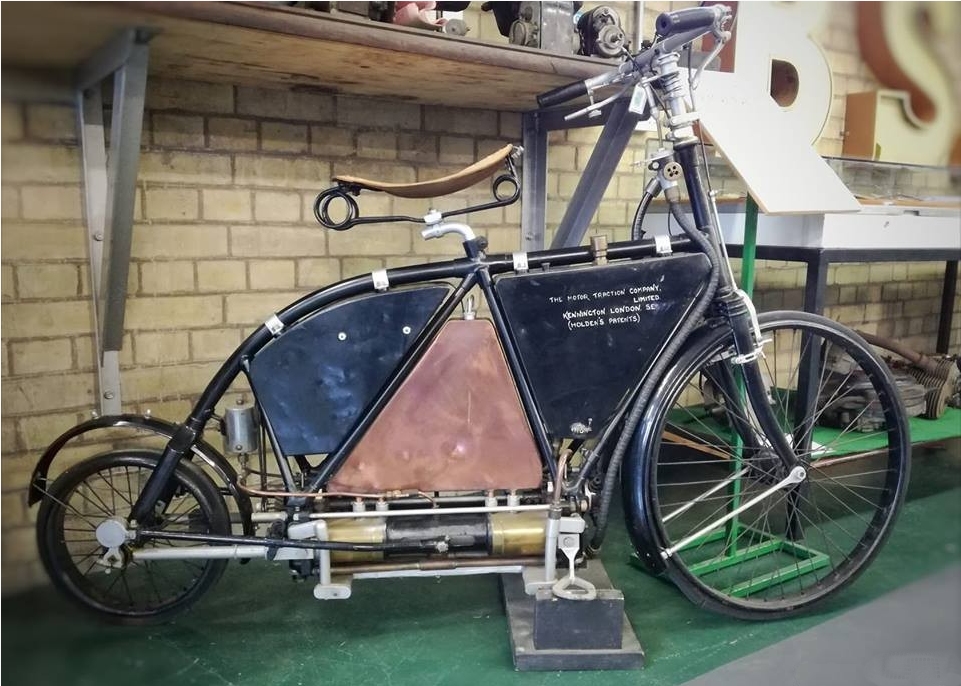 |
| Left: The Holden motorcycle: 1902
This is the liquid-cooled four-cylinder Holden at the Whitewebbs Museum. It has no visible radiator so the surface of one of the triangular tanks must have cooled the water.
Thanks to Steven McDonald for drawing this machine to my attention.
|

THE HUMBER THREE-CYLINDER MOTORCYCLE
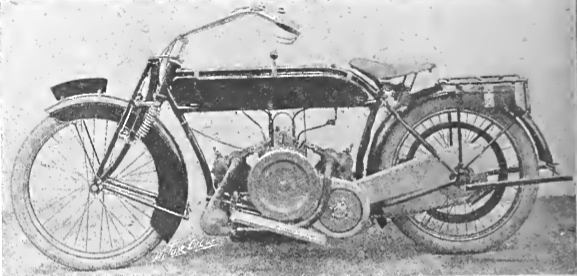 |
| Left: The Humber Three-Cylinder motorcycle: 1913
This Humber motorcycle had a three-speed car-type gearbox, with transmission throughout by chains, and a shock-absorbing device in the rear wheel. The engine has an exposed flywheel and the drive chains are enclosed.
Source: The Motorcycle 1913 day & month unknown
|
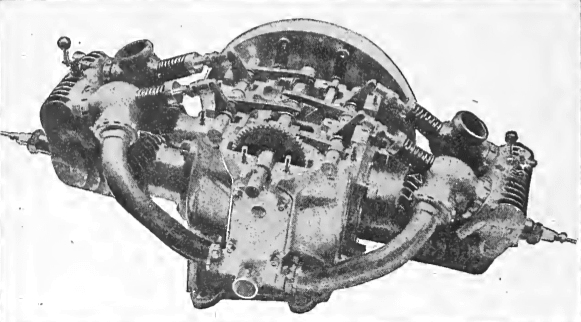 |
| Left: The Humber Three-Cylinder motorcycle engine: 1913
This Humber motorcycle had an asymmetrical horizontal engine with one front cylinder of bore and stroke of 78 x 78mm, and two rear cylinders with a bore of 55mm and stroke of 78mm, having a common combustion space. The front and rear cylinders at set at 180°. The idea was to obtain a perfect thrust balance along the axis of the crankshaft, and so get as even a torque as possible, giving smoothness of propulsion and hence less wear on transmission and the rear tyre.
Source: The Motorcycle 1913 day & month unknown
|

THE MAJESTIC MOTORCYCLE
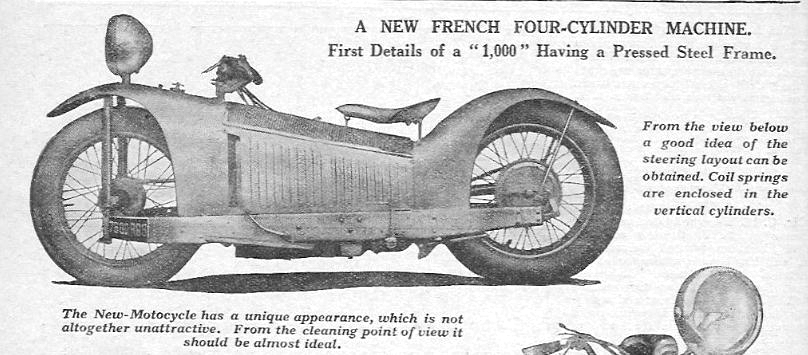 |
| Left: The Majestic motorcycle: 1930
The Majestic was designed by Frenchman Georges Roy. It had a considerable number of unusual features, one of which was a pressed-steel monocoque chassis, rather than a conventional tube frame. It also had hub-centre steering, like the Neracar and the 1907 Scripps-Booth Auto-Bi-Autogo.
Another feature was the 4-cylinder air-cooled engine.
There is a good deal more info here
|
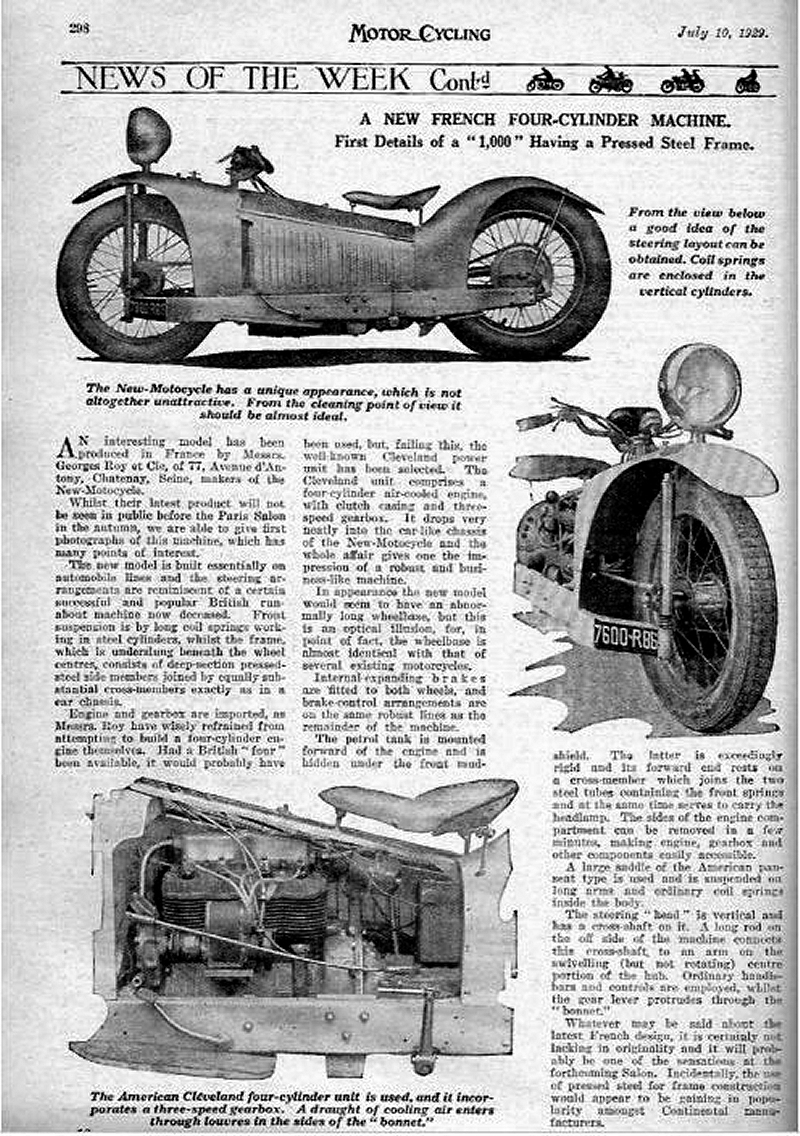 |
| Left: The Majestic motorcycle: 1930
This is the full review of the Majestic as published in Motor-Cycling for June 1929.
|

THE BÖHMERLAND MOTORCYCLES
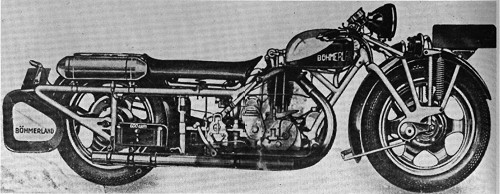 |
| Left: The Böhmerland/Cechie Three-Seater motorcycle: 1935
The three-seater "long-touring" motorcycle was manufactured by Böhmerland/Cechie in Northern Bohemia at Krásná Lípa. (Now Czechoslovakia) This was just one of their models. The company existed from 1925 to 1939, being brought down by the Second World War. Böhmerland is German for Bohemia; Cechie is a colloquial Czech word for the same area.
This machine was designed by Albin Liebisch, who also designed the OHV 598cc single-cylinder engine. (600ccm is written on the black box by the back wheel) The disc wheels were made of light alloy. There were two cylindrical petrol tanks on either side of the rear wheel, supplementing the usual tank at the front. There was no rear suspension. If you felt the seating was inadequate, you could add a sidecar, so you could carry as many people as in a motorcar.
|
 |
| Left: The Böhmerland/Cechie Four-Seater long-touring motorcycle: 1929.
This is an apparently unique four-seater version of the "long-touring" motorcycle above; it is 10.5 feet long.
598cc does not seem very much capacity to move four people...
|

THE ROADOG MOTORCYCLE
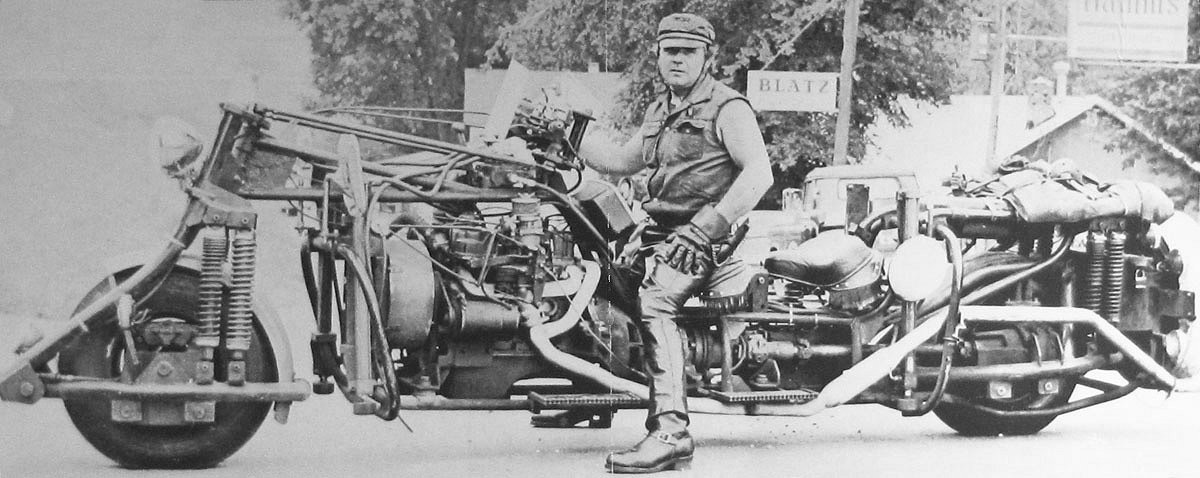 |
|
Above: The RoaDog motorcycle: 1965.
This enormous machine, looking rather like a Böhmerland on steroids, was built by William “Wild Bill” Gelbke in 1965 as his personal ride. It was powered by a four cylnder Chevrolet II car engine with its PowerGlide transmission, and a cut-down Chevrolet truck differential which drove a wide rear wheel. Gelbke built several version of the machine from 1963 to 1973. He died in 1978 "due to a domestic dispute"; a little reseach revealed that this actually meant he had been shot dead by the police when they raided his rented farmhouse. The Roadog version shown above still exists and is on permanent display at the National Motorcycle Museum in Iowa, USA.
|
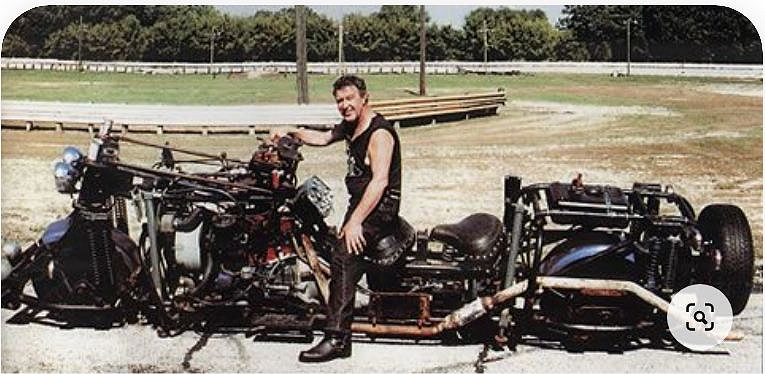 |
| Left: The RoaDog motorcycle: 1965.
The RoaDog was reported to weigh almost 3300 pounds, (1.5 tons) which is more than the Chevrolet car its engine came from. When you wanted to stop four hydraulic jack/stands kept it upright. Making a turn required some forward planning due to its 17 foot length and limited steering lock.
It has only just emerged that two RoaDogs were built. The second one is in private hands.
The RoaDog motorcycle has a Wikipedia page, which gives a good amount of technical detail.
|
 |
| Left: The RoaDog motorcycle: 1965.
The RoaDog on display in the National Motorcycle Museum in the USA; this looks like the one pictured above.
There is more information on the RoaDog here, with lots of photographs. Sadly the National Motorcycle Museum closed in September 2023, and it was proposed to auction the museum's collection.
|

MULTI-ENGINE MOTORCYCLES
Twin-engine bikes have been built for drag-racing, but Roetger Feldmann's 24-engined bike is unique.
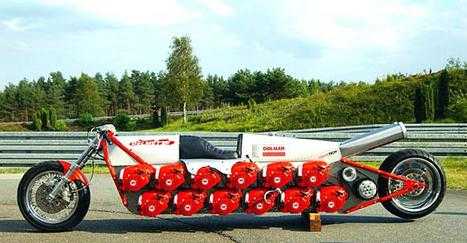 |
| Left: The "Dolmette" 24-engine 24-cylinder motorcycle: 2004.
This 4-meter-long motorcycle was constructed by German comic writer Roetger Feldmann, ("Broesel") and is powered by no less than 24 chain-saw engines coupled together. It is called "Dolmette", as its 24 single-cylinder two-stroke engines are taken from Dolmar PS7900 chain-saws. The result is a total of 1900cc, and 170 HP at 15,000 rpm or 260 km/hr. (161 mph) Whether the bike has actually travelled at that speed is currently unknown. It has a Harley-Davidson 5-speed transmission.
|
 |
| Left: The "Dolmette" 24-engine motorcycle: 2004
German comic writer Roetger Feldmann ("Broesel") created a biker character called "Werner", a notorious deadbeat bike-tuner. After his creation had become successful, Broesel decided to construct some of his comic-book inventions in reality for marketing purposes. That's Broesel on the left. His website is at: http://www.werner-broesel.de/
Note the enormous twin exhaust-pipes.
|

Putting the Dolmette in the shade is the Whitelock Tinker Toy which has either 48 cylinders or 49 cylinders, depending on exactly how you count them. This remarkable motorcycle was built by the Hertfordshire Superbike Centre in the UK.
The complete engine is so large it has a complete single-cylinder 2-stroke sub-50cc engine to serve as a starter motor, hence 49 cylinders. According to some sources the starter engine is 75cc.
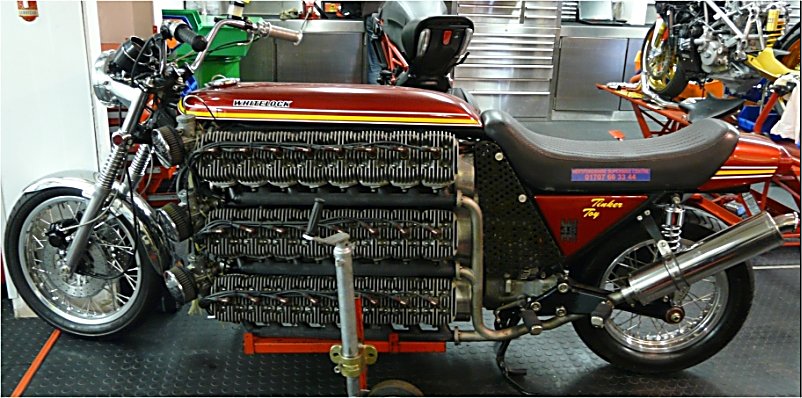 |
| Left: The 48-cylinder motorcycle: 2004
It consists of 16 Kawasaki KH250 2-stroke 3-cylinder engines arranged in six banks of eight, giving a total capacity of a frightening 4200cc. The composite engine is coupled to a BMW K100 gearbox. The bike is said to be completely road-legal.
The wheels on the side are simply to hold it up for display.
More details here, which includes a fascinating video.
|




























